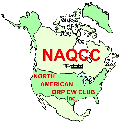
 | NAQCC News |
| Jun 9, 2012 | NAQCC Web Site | Issue #168 | |
|---|---|---|---|
|
IMPORTANT: THIS WILL BE THE LAST OF OUR TWICE A MONTH NAQCC NEWSLETTERS. SEE THE CLUB NEWS SECTION BELOW. In this issue: 1. June Sprint 2. May Challenge Results 3. General Club News 4. Chapter News 5. NAQCC QRS Nets 6. CW Assistance Project 7. CW Cartoon of the Month 8. Member Spotlight 9. News Items and Articles by Our Members |
| 1. JUNE SPRINT(S): - We had an email from someone who only signed with a very common first name saying something to the effect he wasn't going to enter our sprints any more because the same people win all the time. We hope his attitude about winning is not common among our members because our sprints are not about winning or losing. Everyone who enters our sprints is a winner because the objective of our sprints is not to have competition, but to have activity. This is why we never emphasize high scores, but we emphasize the amount of activity in a sprint. We want everyone to participate and have fun. If you read our soapboxes, those who enter and only make a few QSOs are having just as much fun as, if not more than those who make the 'big' scores. Let's talk a bit more about winning. It's natural the same people or group of people are going to 'win' a lot. There are three main ingredients to winning contests: 1. Location. 2. Antennas. 3. Skill. If someone located on a hilltop competes against someone in a valley with more or less equal antennas and skill, who is going to 'win'? Right. If two folks located on hilltops compete with equal skill, but the one has an inverted V at 75 feet, and the other has a short hunk of wire in the attic of his house. Who is going to 'win'? Right again. Skill helps to a certain extent, but two equally skilled operators can have vastly different results depending on their location and antenna system. This is why we 'handicap' our sprints by dividing them into two main groups - those with simple wire antennas and those with big gain type antennas. It's also why we list the antenna system for each participant. If you do want to compare your score with others, you can do so somewhat fairly by comparing them only with folks with similar antenna systems. If there were some way to do so, we'd incorporate some kind of location info also. We do take into account geographical location by sub-dividing our SWA category into divisions by call area. I'm going to cut this short now. I think you get the point and why the obsession with 'winning' should only be secondary to participating and having fun because you are never going to beat the ham with a better location and antenna system no matter how skilled you are. The only contest that comes close to being completely fair about winning is the WRTC where several teams of 2 operators and a 'judge' are brought together to a small geographical area of the world with each team competing with as similar a location, antenna system, and rigs as possible. Of course our sprints can be completely perfectly fair in that regard also. How? Compete only against yourself. Try to better your score, and your contesting skills each time you enter a sprint. That way you are competing only against an equally equipped and operated station. So come on out and fire up your station, no matter how big or how humble it may be and enter our sprint this coming Tuesday evening June 12 from 8:30 to 10:30 PM EDT which as everyone should know translates to Wednesday June 13 from 0030Z to 0230Z. Don't think about winning, think about having fun and participating. You'll get more enjoyment that way, I guarantee. If you are new to the sprints, please read the complete sprint rules carefully so you'll know exactly what we need in the form of logs. While it is not necessary to use a computer program for your sprint logging, if you do use our recommended GenLog program correctly, then submit via the autologger, it will take you the least amount of time to compile and submit your log and report. Just a few minutes in most cases. If you have any doubts about using GenLog, check out our illustrated tutorial on using the program. I've also created a 'check list' or 'tutorial' on how you can be almost guaranteed to have a GOLDEN LOG. This supplements the info in the Sprint General Rules. Check it out here if you haven't been getting a GOLDEN LOG lately. Maybe you'll see where you've been going wrong. There is a plain text file (one for each continental USA time zone) of upcoming sprint dates for the rest of 2012. See the 'Print a Schedule' page in the 'Contests/Sprints' section of the web site. Print it out and post it somwhere prominently so you won't miss a single one of our sprints. IMPORTANT: Don't forget we have a second sprint this month also. One of our two milliwatt sprints we hold each year. I won't put the time and date here to avoid confusion with our regular sprint, but as always, it's on the web site. Read and understand the full general sprint rules and any specific rules for this month's sprint here. 2. MAY CHALLENGE RESULTS: This was a different type of challenge thought up by Tom WY3H in which he challenged you to work each of the 10 USA call areas, but with a twist. The stations you worked must have the correct number in their call sign for that particular area. For example, only stations with a 3 in their call could be used for the W3 area of PA, MD, DE, and DC. Since this newsletter is being published before the results submission deadline, you'll have to check the challenge pages for complete results. As of now (Jun 7), 5 folks mastered the challenge with all 10 call areas and 8 others sent in their results to get a Participation point with 5-9 areas worked. We also now have a new helper associated with the challenges. Hap W7HAP is taking care of the results pages similar to what Dean NW2K is doing with the sprint results pages. The transition is just taking place now, and when completed, you'll submit your results to him at an email address shown in the rules. Watch for that. Full Challenge results can always be found here. 3. GENERAL CLUB NEWS: The job consists of filling in names, calls, and other pertinent info on our master certificate files and emailing them to the winners. Also updating the awards page when new awards come in and emailing to page to me for updating. It would involve certificates not only for our Awards program, but for the sprint and challenge winners. If you don't know HTML for the web page, we'll train you. Please contact As a result, I'm doing everything I can to cut back on my work load in at least a couple of ways. Farming out tasks to members to perform helps a lot. Also cutting back on some things involved with the club helps. When I first brought up this matter, I received a suggestion that cutting back to a once-a-month newsletter should be a big help. I've mulled that over for a few months now, and finally agreed it is a good decision for the following reasons: 1. Contributions of material for the newsletters is really almost nil when you consider we have well over 6,000 members now. The Member News section over the past several issues has had these number of items from members excluding the item each issue from K3WWP: #167 - 0, #166 - 2, #165 - 5, #164 - 1, #163 - 3, #162 - 3, #161 - 2, #160 - 0, #159 - 2, #158 - 0, #157 - 5, #156 - 1. That's an average of 2 items for the last 12 issues, and that pattern continues back as far as you would want to check. Many of the items are from the same few members. ADDENDUM: Now if we could have more excellent items like those in this newsletter from KK4EQP and N8ZYA for each issue, it would be worthwhile having two newsletters a month. However such great items are few and very far between. 2. The CW Assistance section goes wanting for material each issue because our CW Assistance director Ron K5DUZ does not have time to contribute material, and except for K3WWP writing material every other issue or so the section would be totally blank. No one, with the exception of one or two members, has contributed anything to this section in probably a year now. 3. Other sections of the newsletter fare better, but would not suffer by cutting the number of issues in half. In no particular order let's look now at farming out work and I hope I don't forget mentioning anyone here: N8XMS provides the Member Spotlight faithfully and promptly for each issue. KJ4SI is very good at providing the net reports for each issue as well as contributing other info about the nets every other issue or so. NW2K taking care of sprint results pages for regular sprints. VA3PEN doing the same for our special sprints. K7HAP taking care of the challenge results pages and also he will handle tracking the Participation award shortly. VA3RJ handles public relations for the club. KD2MX edits the Member News (what there is of it) for each issue. He is also the one in charge of recruiting new members for the club. AA4W handles all details of our club awards program. (but he must quit - see above item) K5DUZ is in charge of CW Assistance. KC2EGL handles the details of our prizes program. WY3H comes up with our challenges each month. K3RLL indexes our newsletters. W7GAH does the regular checks of the FCC database for member updates. VE6CPP handles details of our monthly polls. These folks are also helping (or have helped) with various tasks: W3IRS, SWL-25, W2LJ, MW3YMY, WD0K, KE9DR, N3IJR, VA3RKM, KC8FS (SK), W5RJ (SK), EI2GP, K4IWL, N9GOD, 2U0BGE, WB0OEW, WB9TPA, AF4LB plus several NCS stations and alternates. If I left you out, blame it on my old age and overwork. Even with all that help, the everyday little tasks of running the club take up a lot of time. Things like cross-checking of logs (which I will never farm out), answering all kinds of email questions about this or that (which I would love to farm out if there were someone else who knew all the little details about the club), keeping our master database of members (which also will not be farmed out), and among others like that mentioned in the following news item, writing and compiling these newsletters (which now will be cut back from a twice a month job to once a month. I think all the above info is justification for the cutback in the newsletter. As a result the next newsletter will not be June 30 as may be mentioned elsewhere, but the Saturday before our July sprint - July 14 (Bastille day, if that means anything, maybe my freedom???). From then on, each newsletter date will be the Saturday before our regular monthly sprint. In the future should member news contributions increase manyfold and our CW Assistance section come back to life, we may consider returning to a twice a month format. N1A - W1OH N2A - NW2K KQ2RP N3A - K3WWP WY3H KC2EGL WA3HIC AF3Z N4A - AI4SV K3RLL KI4EBD N5A - WD5EAE KK5NA N6A - K6MGO N7A - WC7S N8A - N8XMS (tentative) N8IUP AC8AP N9A - KR9Z N0A - KD0VIt's looking better, but we still need more ops, especially from those areas that have only one op signed up. In fact for all areas. We can't have too many ops. The more ops, the more air time for our N#A stations. Check the page we mentioned if you are interested in signing up or want more details. Thanks to those who have signed up already. Those in red will operate the sprint that week. We need all ten special calls active in the sprint. From K4CHT #0009, "Jesse Paul Wright (KI4KKW #0888), age 22, of Morristown (TN), passed away Friday, May 11, 2012 at Morristown-Hamblen Healthcare System. He was a graduate of Morristown-Hamblen High School East, was active in the U.S. Army, and was a member of the V.F.W. Post 5266. Funeral services (were) at 8 p.m. Monday, May 14 at Westside Chapel Funeral Home with the Rev. Christopher Dotson officiating. Graveside services (were) at 11 a.m. Tuesday, May 15 at Bethesda Cemetery with full military honors." Our deepest sympathies go out to K4CHT and all other family members and friends of Jesse. 4. CHAPTER NEWS: Here is where our club chapters present news about their chapter activities. We currently have three chapters - European, Texas, and Western Pennsylvania. We're looking forward to expanding that roster. Chapters are more or less independent local gatherings organized by members in a geographical area and subject to a list of guidelines under the auspices of the NAQCC. If you would be interested in starting a chapter in your area, let us know and we'll send a copy of the guidelines. NAQCC EUROPEAN CHAPTER:  Items in this section are from EU Chapter President Matt MW3YMY unless otherwise credited. Questions or comments should go to Challenges As publicised in the previous two newsletters, June sees the first in what will hopefully be a long series of European challenges. These challenges aim to provide alternatives to the main challenges directed specifically at CW enthusiasts in Europe (although they are open to everyone). The June challenge involves making the words from a list of countries from the calls of stations you work and has already started, but it's certainly not too late to get involved! Full details can be found here. There are over 550 members in the NAQCC currently residing in Europe, which is plenty to make some very successful challenges! Please support the chapter by taking part. Note from K3WWP: It was a great honor for me to be the first one to successfully complete the first ever EU Challenge this month. It took me but 4 days to do so using only QSOs with EU stations. Thanks to Ton PA5LR for coming up with the concept of alternate EU challenges. Sprints After a few month's interlude of not running any sprints, the European chapter sprints will be back, commencing on Friday 22nd June. The European sprints take a very similar format to those of the main NAQCC sprints, the main difference being that they are held at times that are much more convenient to those on the other side of the Atlantic. The first one promises to be great fun, so please support the chapter by taking 2 hours to participate in the sprint and submit a log. Updated rules will be posted on the chapter website at least four days before the sprint and will include details on exact times, the required exchange, frequencies and how to submit your log. All members who submit a log will receive a certificate of participation and those with the top three scores will receive a special certificate. NAQCC TEXAS CHAPTER: 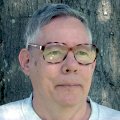 Items in this section are from TX Chapter Director Ron K5DUZ unless otherwise credited. Questions or comments should go to The East Texas QRS Net (ETN) meets each Monday evening at 1900 CDST (0000 UTC). The net is on 7060 KHz until next fall. The ETN net is open to all comers, not just stations in Texas, so if you hear the net in session please check-in with Allen, KA5TJS, #4512, the NCS. Conditions for the ETN were really bad this week. Work conditions that is! Allen, KA5TJS had to work late so the net was not held. This was a rare occurrence, so please look for the ETN next Monday evening. Check the weekly NAQCC net e-mail for the latest ETN info. Wow! It's almost time for the June 12th (Texas time) Sprint already. Last month we had Remember that all NAQCC members located in Texas (363 at last count) are automatically members of the Texas Chapter. We would love to hear from you about any of your recent ham activities, new QRP rig or antenna. NAQCC WESTERN PENNSYLVANIA CHAPTER:  Items in this section are from John K3WWP unless otherwise credited. Questions or comments should go to The NAQCC WPA Chapter had a great time at the Butler, PA hamfest on Sunday June 3. It's so great to be able to get together in person with other hams in your area to engage in activities together. I don't know why more areas don't form NAQCC Chapters. 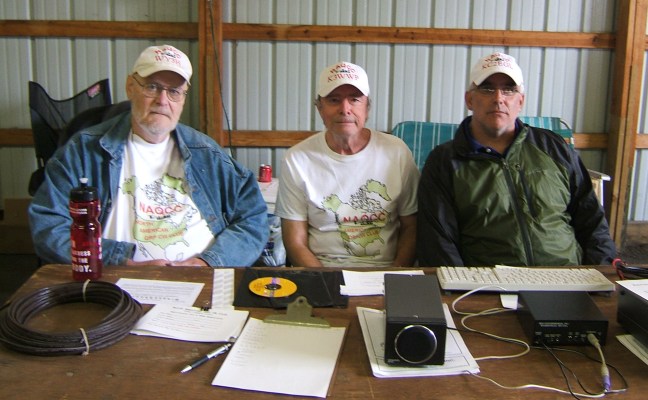 Tom WY3H, John K3WWP, Mike KC2EGL above L-R, and Don K3RLL below L with Mike, set up an NAQCC table at the hamfest to meet other area members and to sign up new members. Since many of those who attend the Butler hamfest regularly have already become NAQCC members, we only signed up 4 new members, but it was great to welcome aboard the following: #6065 Russ KB3WTC #6066 Eric KB3NSK #6067 Shaun KB3CXQ #6068 Nick WA3NB 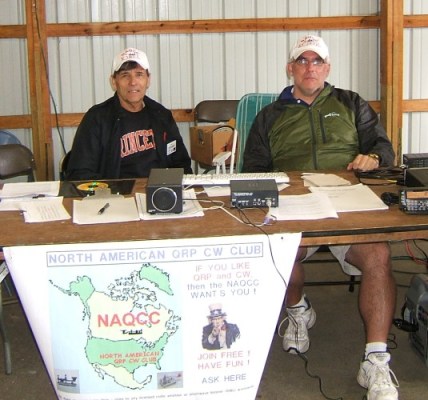 We also had the following members stop by the table to say hello and sign our visitors list: Bob W3BBO, Frank KB3AAG, Dave KD3EM, Brian W3PDW, Dan WA3MKN, Tom KI3R, Jim, W3IU, Scotty KG3W, Jerry W3DMB, Kevin KE3V, Bob WC3O, and non-members K3RS and John KB3SVJ who says he will join when he becomes comfortable with CW. We hope that is soon. After the hamfest Mike and Don stopped by my house for a couple hours to chat about ham radio and other things. We also worked some DX from my station. All three of us worked FG5FR on 12 meters. It turned out that was Mike's first ever 12 meters QSO. Conditions were not as good at that time of day (late afternoon) as when Mike and I had been getting together in the evenings on a few previous visits the past couple weeks. Mike and I worked many good DX stations during those chapter get-togethers. I see some 30 DX QSOs in my log the past week or so following the WPX contest, and Mike also worked many of those stations. John K3WWP and Don K3RLL are planning a portable operation sometime next week (June 11-15). If we decide to use our NAQCC club call, we'll send out an email notification on our mail list so you can try to work us for a 5 point QSO toward our Friendship Club Award. 5. NAQCC QRS NETS: 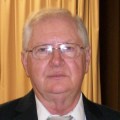 News and net reports in this section are from QRS Net Manager Gary KS4JI unless otherwise credited. Gary will handle all Net related material at this email address: The latest NAQCC QRS Nets schedule can always be found on the NAQCC web site here. Recent Net Activity report: Net Name (Abbreviation) Date(UTC) NCS Participants NAQCC Main QRS Net (NQN) - Sunday 5-27-12 N4PLK (NCS) -6- N4PLK N4JD AA6WQ N6TLU (ANCS) W4HH W1SFR 6-3-12 N4PLK (NCS) -12- N4PLK K3NLT W4HH N4OLN K3VIG N9RLO N8IUP N9TMU K9EYT K1IEE W1TJ N6TLU (ANCS) NAQCC East Texas QRS Net (ETN) 5-28-12 KA5TJS (NCS) -4- KA5TJS KE5BUS KE5YGA KG0YR 6-4-12 NCS not available or Alt. NAQCC Pacific NorthWest QRS Net (PNW) 5-24-12 KE7LKW (NCS) -3- KE7LKW WB4SPB K7ZNP 5-31-12 KE7LKW (NCS) -4- KE7LKW K7ZNP N6KIX KB7DYP NAQCC Rocky Mtn Regional/Continental QRS net (RMR) - Tuesday 5-22-12 WC7S (NCS) -1- WC7S (Poor conditions. NCS called but no response) 5-29-12 WC7S (NCS) -4- WC7S N8IUP KB5JO/VE3 K1IEE 6-5-12 WC7S (NCS) -2- WC7S WB1HGA NAQCC Rocky Mtn Regional/Continental QRS net (RMR) - Thursday 5-24-12 WC7S (NCS) -2- WC7S KG0YR 6-7-12 WC7S (NCS) -5- WC7S K4EAY KG0YR WA8REI KU7Y NAQCC East Coast QRS Net (ECN) NAQCC Pacific NorthWest QRS Net (PNW)For more net info, see CW Assistance/QRS Nets on the web site. 6. NAQCC CW ASSISTANCE PROJECT:  Items in this section are from CW Assistance Project Coordinator Ron K5DUZ (L) unless otherwise credited. If you are interested in helping out or need help with any CW and/or QRP matters contact: K5DUZ - As mentioned all too often with no results, we need YOUR help with this section and the CW Assistance Program in general. Enough said. Let's hear from you. 7. CW CARTOON OF THE MONTH: 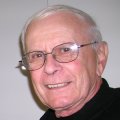 Let's take a comedy and/or nostalgia break now courtesy of Dick Sylvan W9CBT NAQCC #2062. Dick has been a long-time QRP/CW operator. One of his many talents is being a cartoon artist. Dick's cartoons appear monthly in the K9YA Telegraph, a free ham radio eZine, where he is staff cartoonist. The NAQCC is very honored to reprint Dick's cartoons originally published in the K9YA Telegraph. Dick has also authored a book entitled "Hi Hi - A Collection of Ham Radio Cartoons" available via his web site. A new cartoon has appeared in each of our even-numbered newsletters ever since their debut in Issue #058, November 17, 2007. 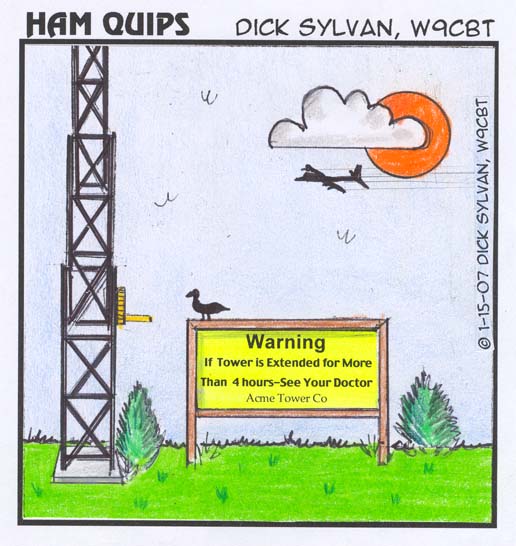 8. MEMBER SPOTLIGHT: 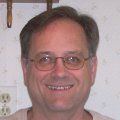 This section is managed by Paul N8XMS and any questions about it should go to Sidney Sudberg K6DMT #5507 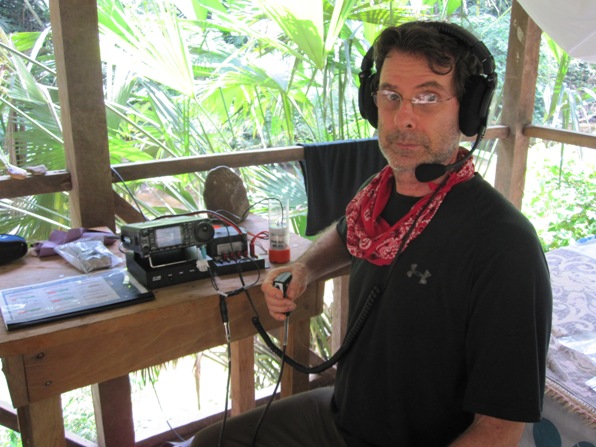 Being an electronics enthusiast as a young boy growing up in the Bronx and Brooklyn, NY in the 50's & 60's, I developed an interest in Morse Code and Ham Radio but not having any means to pursue this hobby at the time, I moved on to other interests. Not until about 2 years ago when my wife showed me an article in the local newspaper about a Ham Radio Club, SOARA, right here in my hometown of Mission Viejo, CA that was having a Field Day. I told my wife we were going to this event and as soon as I arrived and saw all the radios and antennas, I knew I had come home, literally. It was down hill from there, I and my wife both got our Tech licenses in a few months and by the following year I got my General and in March, 2012 I obtained my Extra ticket. In the last couple of years I have been spending every spare moment catching up and learning about this fantastic hobby, as well as every spare dollar getting all of my rigs complete and ready for operation where and when ever needed. I currently have an Icom 7000, a Yaesu 817ND, and an Elecraft K1. I have been learning CW and am passionate about CW/QRP. I use a Buddipole, Par EndFedz wire antennas and random wire antennas at home and in the field. At my business, I use my Icom 7000 with a Hustler 5-BTV. I am a dedicated member of my local ARES/RACES group because I feel EmComm is the best practical application for Ham Radio. For my enjoyment and the challenge I pursue CW/QRP with a passion. At home, I am gearing up to ride my Icelandic horse, Tindur, into the local hills with one of my QRP rigs to get some CW/QRP experience. My other interest is to take my next rig, the Elecraft K2, with me on my annual journey as a Medicine Hunter to the Peruvian Amazon Jungle, to communicate with the states with the limited resources that I bring with me. I am a Natural Products chemist and direct a Quality Control Laboratory for the dietary supplement industry and once a year I go to the jungle to search for potentially beneficial botanical medicines. Last year I brought my Icom 7000 with me and had little success in making any QSO's due to my inexperience but I am optimistic that this year, with proper preparation, I will surely make some QSO's and hopefully with some of you. 73, Sidney Sudberg (K6DMT) 9. NEWS ITEMS AND ARTICLES BY OUR MEMBERS: 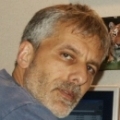 This section is a forum for you to tell other members what you've been up to on the ham bands or to submit an article dealing with some aspect of CW and QRP operation or equipment. Examples might include, but not limited to, antenna projects, QRP and/or SDR equipment, tuners, battery technology, keyers, logging, or other related topic of interest to the QRP community. Send your news items and articles to our news editor Paul KD2MX at For my other news, check the WPA Chapter section above if you skipped over it on the way down here. Of course if you wish, you can also check out my other exploits on my web site and the diary there. If you haven't visited before, there is also a ton of info about CW and QRP operating. The site is right here I first learned Morse code as a kid by reading the Boy Scout Handbook. I think Morse code is a lot like walking, or riding a bike. It stays with you forever, although maybe at a much slower speed, hidden in the inner parts of the brain. I recalled it when I was a Boatswains Mate on a US Navy destroyer in the late '60s. Morse code, sent on a searchlight, can only be sent around 10-12 wpm before it "blurs" to the eyes. Many times Morse code was sent slower, and those early years of memorizing code from the Boy Scout Handbook came back to me. I could still remember it, and when others realized this, I was immediately transferred to the signal bridge. I also learned the art of semaphore and I memorized procedural flags which were used when hung from the yardarms of the ship. I can't count the times I've heard other hams say "life it too short for QRP" and above all else CW, but I've operated from rental apartments, or antenna restricted areas, for nearly 20 years and I've found just the opposite to be true. I think life is too short to use a microphone for all my contacts. I'm proud to be a CW operator and given the chance, always prefer a CW contact. I also prefer a long chat to a handshake. My station is very simple. I keep my Icom 703 on a small aluminum camping table with a small digital travel clock, set to GMT time, and my Vibroplex key along with some paper and a few ink pens. My Isotron 40 and 20 meter antennas are attached to a painters pole which is bungee corded to a bed post in the room. I feed it with 10 feet of coax. After nearly 20 years, I'm still operating from a compromised position just a few blocks from the state capitol building in Charleston and in a historic area that doesn't allow outside antennas. I have an eleven story apartment building next door and live in a valley at 630 feet elevation. I check propagation forecasts and DX clusters with a net book computer. It's all very simple; as a QRP station should be. I also have room for 10 and 15 meter dipoles inside my home which can be set up in a matter of minutes when I find open bands. 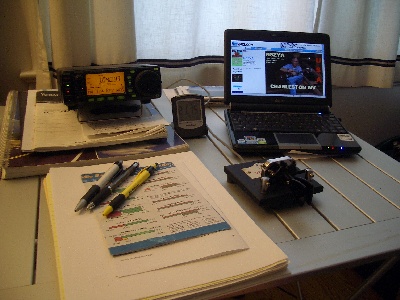 When I retired from a paint company a few years ago, I finally had more time to devote to my hobby. I've discovered just how easy it is to work DX stations with 5 watts. Those who bemoaned the QRP mode, and considered life too short for low power operation are often amazed to hear, that since 2009, I've worked 191 DX stations in 53 different countries. Out of nearly 1400 contacts, very few have been due to contesting. My radio does not have extra filters. I've also worked 18 stations at better than 1000 miles per watt. It's nice to sit at home and take advantage of band openings but the real joy of QRP operation is being outside or traveling with my radio. I operate in the field as often as possible, using simple dipole antennas. I travel to New York and North Carolina several times a year and take along my QRP rig. A few weeks ago, I set up the station on the Outer Banks of North Carolina and worked several South American stations. I also set up and operate from many places in West Virginia. I usually make up special cards when I do this and send them to the stations I've worked through the internet. 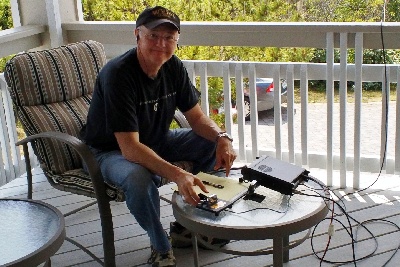 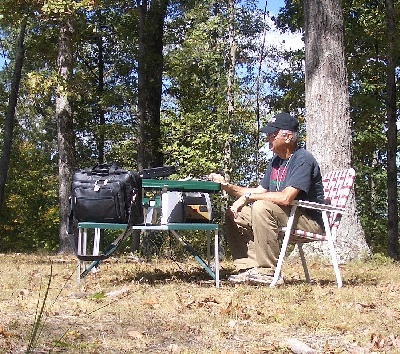 I like to write, and share with others, the fun I've had while operating QRP. I keep an online journal on Blogger.com: http://n8zyaradioblog.blogspot.com/. The North American CW QRP Club is my favorite club because they use CW exclusively and its' members always operate at QRP levels. I really need to update my awards but will wait for the winter months to do so. I've worked 227 members now (get in that Friendship Club application! - K3WWP) and look forward to working many more in the next 20 years. I love the simplicity and the ability to operate portable radio in the field. I am trying to get in the habit of laying out all my components and parts before I get started. This helps me keep the bench looking less like a war zone. As you can tell by the different audio jacks, most of the components for this project came from my own inventory of parts, with the exception of the LM567 and the 10K pot, which I bought from Mouser. 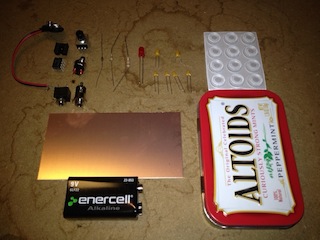 Getting an idea of how I was going to fit the board, battery, and jacks in the Altoids tin was the first order of business. I simply laid the battery in the box, held the bigger audio jack in place, and estimated the width of the board. I chose 1.5" x 2". 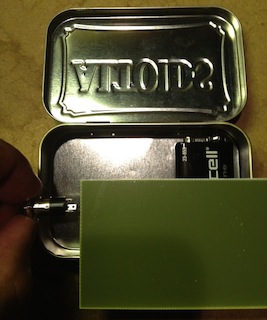 After having a "clear as mud" picture in my head of the board placement, I measured and marked the board before I trimmed it down. 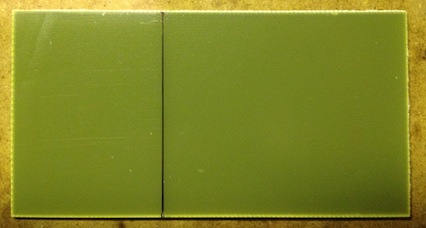 In the recent past, I would use a cutting disc Dremel attachment to cut PCB boards. One day I discovered that my sheet metal sheers did quite a nice job at cutting PCBs, less messy too! 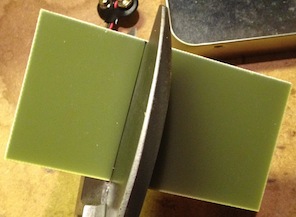 Plenty of room for everything... 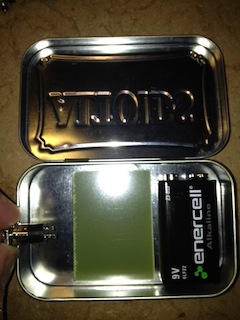 Next, I get ready to drill the pilot holes for my audio jacks. Make sure your drill bit is not worn out. Altoids boxes are pretty thin, so you want a nice sharp drill bit that'll do more cutting than denting, else you'll end up with sunken holes. 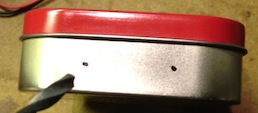 Now for my favorite drill bit, the step drill bit. I could've just used a drill bit large enough to accommodate an audio jack, but I'm already accustomed to the pilot-hole-step-drill method.  A view of the audio jacks in place... 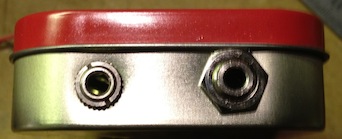 Stick on some rubber feet. I purchased these at my local Lowe's Hardware store. 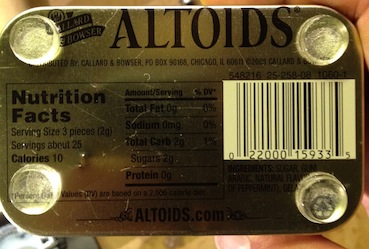 Uh oh! Found a problem. My intent is to secure the board to the lid of the Altoids box using the temporary pushbutton switch soldered to the board, it has threads and a nut for panel mounting. But with a 1.5" x 2" board, the edge closest to the hinge will hit the compartment portion of the box. I had to further trim the board down to a 1.5" x 1.5" square. 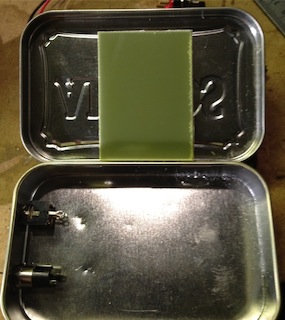
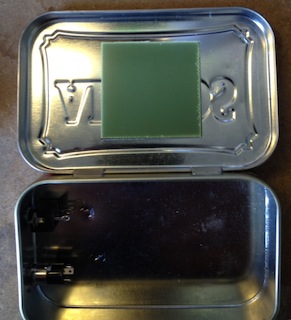 Time to start drilling holes. I use my dremel and a small 1/32" bit for the small lead components, a 3/64" bit for the pushbutton and potentiometer, and a 1/8" bit for the tabs on the pot. 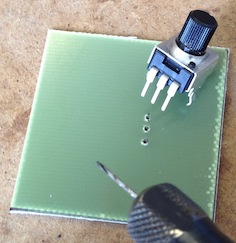
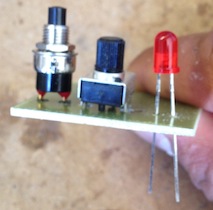
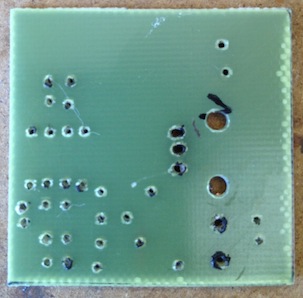 I used a diamond point grinder attachment for my Dremel to cut the PCB tracks. Why don't you just etch your boards, Julio? I just don't want to deal with neutralizing and disposing of the harsh chemicals used in PCB etching. I guess that's the environmentalist in me :-) Remember to leave copper all the way around your holes to ensure the solder gets all the way around the lead. Additionally, use your multimeter to test for any shorts between the tracks and the ground plane. I messed up one of the holes on the board, you can probably see it, it's towards the upper left corner. Oops. 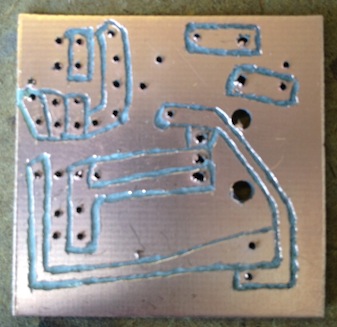
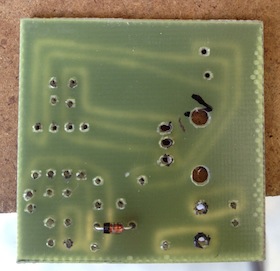
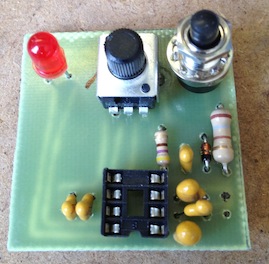 I normally start with the components closest to the board, in this case the diode, followed by the resistors, socket, capacitors, and finally the pot, LED, and switch. Now back to the enclosure. I drilled three holes for the switch, pot, and LED. 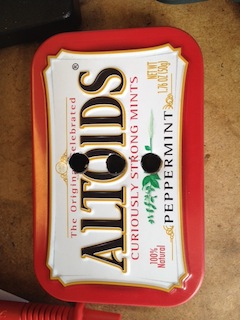 Next I wire up the audio jacks, ground to ground, signal line to signal line. On each jack I joined the left and right channels. 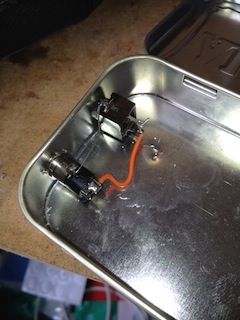 Here's a bottom view of my novice soldering job and a view of the board ready for mounting in the box with the power and audio input cables soldered in place. 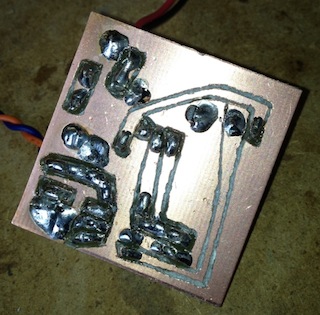
 And finally pictures of everything mounted inside the Altoids tin and the final product. 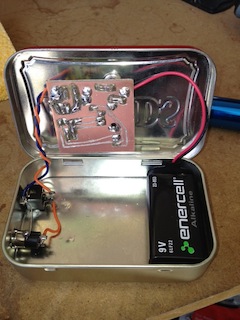
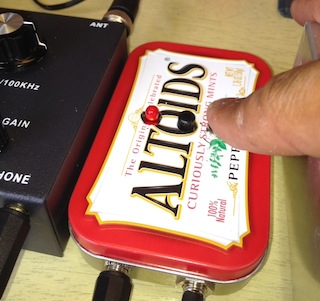 I should've used a multi-turn 10k potentiometer. I found that when calibrating the circuit to the target tone frequency it was increasingly sensitive compared to a multi-turn pot, with which you would have a little more wiggle room. A word on calibration, this circuit requires a pretty strong signal for the tone decoder to kick in. I tried to use my HB-1B QRP rig to calibrate it to its sidetone, but it wasn't loud enough to engage the decoder. Instead, I used my K1EL keyer and cranked the volume up until I had good LED flashes on the Zero Beat Tuning Aid. This was a fun little afternoon project. Its simplicity leaves lots of room for interesting improvements. The builder could add an adjustable pre-amplifier to detect weaker signals. Maybe even use multiple LM567s and LEDs to detect a "close to" but "not quite" zero beat, perhaps a redyellow- green-yellow-red LED array that gets closer to green as you zero beat a station. I believe this would even give more accessibility to hearing-impaired hams, by having a visual aid in addition to the audio. The possibilities are vast. Thanks for reading. |
Club email address - The publication of our next newsletter will be announced via email to all members for whom we have a valid email address unless you specifically have unsubscribed from the email. Past on-line newsletters beginning with issue #042 are now archived on the site. So if you missed seeing any past issues, you can check them out in the archives. Unless otherwise credited, all items are written by K3WWP. If you came directly to this newsletter, we invite you now to browse the NAQCC Web Site. |